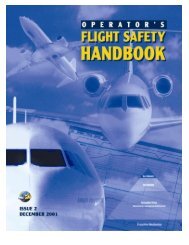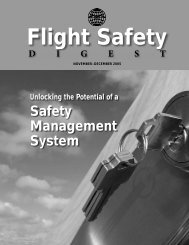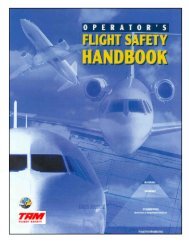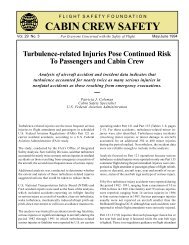Download PDF [10.9 MB] - Flight Safety Foundation
Download PDF [10.9 MB] - Flight Safety Foundation
Download PDF [10.9 MB] - Flight Safety Foundation
Create successful ePaper yourself
Turn your PDF publications into a flip-book with our unique Google optimized e-Paper software.
Next month, I am scheduled to give<br />
a presentation at the International<br />
Union of Aerospace Insurers’<br />
(IUAI) annual general meeting.<br />
The topic is “2012: Blip or Step-Change.”<br />
This speaking engagement is significant<br />
on a number of fronts. First of<br />
all, the IUAI meeting is being held in<br />
Bermuda and, as most of you probably<br />
are aware, there are worse places to<br />
spend a few days in early June. Secondly,<br />
I recently marked my one-year anniversary<br />
at <strong>Flight</strong> <strong>Safety</strong> <strong>Foundation</strong>, so<br />
I’m interpreting <strong>Foundation</strong> President<br />
and CEO Kevin Hiatt’s approval to<br />
take on this engagement as a vote of<br />
confidence.<br />
Most important, however, is the<br />
subject. Was the much-ballyhooed safest<br />
year since the dawn of time, or least<br />
since the dawn of aviation, a blip on the<br />
continuum or does it mark a permanent<br />
change? Has the industry achieved an<br />
unmatched, sustainable level of safety<br />
excellence?<br />
As we all know by now, the data show<br />
that 2012 was the safest year on record<br />
for commercial aviation, particularly if<br />
you just look at Western-built equipment.<br />
But as we have mentioned in Aero-<br />
<strong>Safety</strong> World, and as was pointed out in<br />
April in Montreal at the <strong>Foundation</strong>’s<br />
FLIGHTSAFETY.ORG | AEROSAFETYWORLD | MAY 2013<br />
FOCUS ON THE<br />
Journey<br />
58th annual Business Aviation <strong>Safety</strong><br />
Seminar (BASS), the same stellar accident<br />
rate isn’t found in all geographic<br />
regions or across all aviation sectors.<br />
The commercial aviation accident rate<br />
is significantly worse in Africa than in<br />
North America; there were more accidents<br />
involving turboprops last year<br />
than involving commercial jets; and it’s<br />
tough to compare commercial aviation<br />
to corporate aviation because it’s difficult<br />
to come up with accurate exposure data<br />
such as number of flights or departures<br />
in the business aviation sector.<br />
My presentation still is in the preparation<br />
phase, and I will depend on Kevin<br />
and others here at the <strong>Foundation</strong> to vet<br />
everything before I actually step onto the<br />
podium in Bermuda, so I’m not yet ready<br />
to answer the “blip or step-change”<br />
question. But I bring up the speech because<br />
with it looming, I find myself very<br />
attuned to what others are saying about<br />
the industry’s accident rate and aviation<br />
safety prospects, and because I recently<br />
returned from BASS, where, of course,<br />
the topic was much discussed.<br />
At BASS, Steve Brown, chief operating<br />
officer for the National Business<br />
Aviation Association, said, “<strong>Safety</strong> is<br />
what defines the public perception of<br />
business aviation.”<br />
EDITORIALPAGE<br />
Of course, that’s true of commercial<br />
aviation, as well. That perception is<br />
a positive when your accident rate is<br />
improving, but could be a negative in<br />
some sectors, such as emergency medical<br />
services, which have seen a spate of<br />
accidents recently.<br />
Merlin Preuss, vice president of government<br />
and regulatory affairs at the<br />
Canadian Business Aviation Association,<br />
said, “It’s getting harder to avoid the big<br />
one.” He pointed to demographics and<br />
said that business aviation is seeing decreasing<br />
experience levels in operations<br />
personnel and increasing complexity and<br />
sophistication in the aircraft being used.<br />
And George Ferito, outgoing chairman<br />
of the <strong>Foundation</strong>’s Business Advisory<br />
Committee and an executive at<br />
<strong>Flight</strong><strong>Safety</strong> International, said that it<br />
is inevitable that there will be accidents<br />
and that “safety is not a destination. It’s<br />
a journey.”<br />
So, where are we in our journey?<br />
Frank Jackman<br />
Editor-in-Chief<br />
Aero<strong>Safety</strong> World<br />
| 5


![Download PDF [10.9 MB] - Flight Safety Foundation](https://img.yumpu.com/18550968/7/500x640/download-pdf-109-mb-flight-safety-foundation.jpg)

![Download this Issue [PDF 7 MB] - Flight Safety Foundation](https://img.yumpu.com/18859635/1/190x245/download-this-issue-pdf-7-mb-flight-safety-foundation.jpg?quality=85)
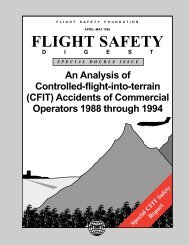




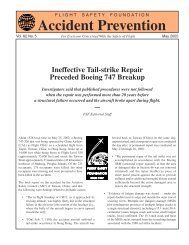
![Download [PDF 8 MB] - Flight Safety Foundation](https://img.yumpu.com/18859366/1/190x245/download-pdf-8-mb-flight-safety-foundation.jpg?quality=85)
